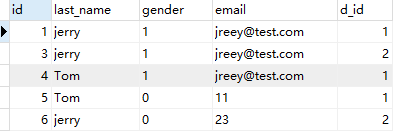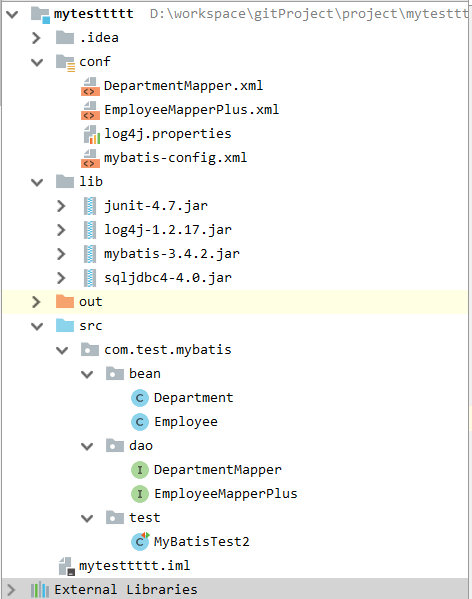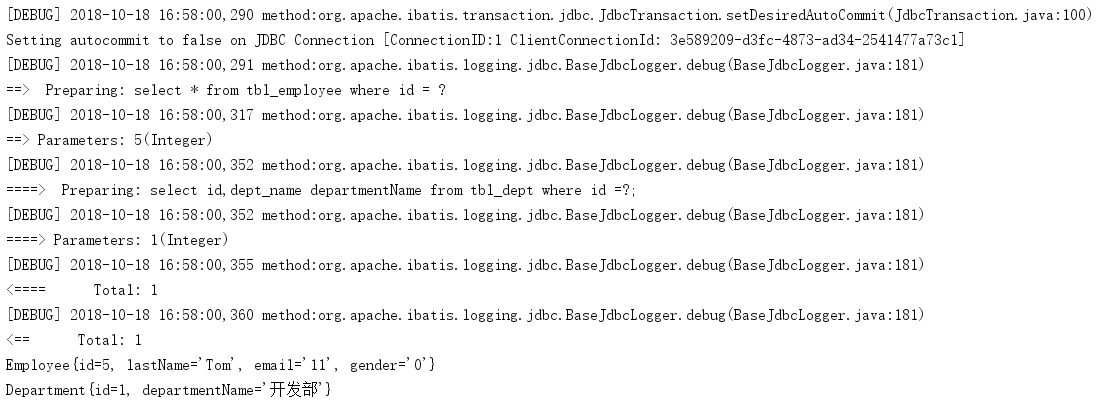mybatis學習筆記之——mybatis的Mapper XML檔案中resultMap屬性
resultMap
resultMap:自定義結果集對映規則,自定義某個JavaBean的封裝規則。
id:唯一id,方便引用。
type:自定義規則的Java類。
具體其他屬性詳細資訊和配置程式碼如下:
<resultMap id="MyEmp" type="com.test.mybatis.bean.Employee"> <!-- id:指定主鍵列的封裝規則(主鍵也可以使用result來定義) column:指定哪一列 property:指定對應的javaBean屬性 --> <id column="id" property="id"></id> <!-- result:定義普通列封裝規則 --> <result column="last_name" property="lastName"></result> <!--其他不指定的列會自動封裝:我們只要寫resultMap,就儘量把所有的列都寫上--> <result column="email" property="email"></result> <result column="gender" property="gender"></result> </resultMap> <select id="getEmpById" resultMap="MyEmp"> select * from tbl_employee where id = #{id} </select>
如果出現如下場景:查詢Employee的同時查詢員工對應的部門,規定一個員工有與之對應的部門資訊(員工資訊表中會儲存部門資訊的主鍵作為外來鍵);資料庫如下設定如下(SQL server資料庫):
員工表tbl_employee:
CREATE TABLE [dbo].[tbl_employee] ( [id] int NOT NULL IDENTITY(1,1) , [last_name] varchar(255) COLLATE Chinese_PRC_CI_AS NULL , [gender] char(1) COLLATE Chinese_PRC_CI_AS NULL , [email] varchar(255) COLLATE Chinese_PRC_CI_AS NULL , [d_id] int NULL , CONSTRAINT [PK__tbl_empl__3213E83F8C42E8B6] PRIMARY KEY ([id]), CONSTRAINT [FK__tbl_employ__d_id__1273C1CD] FOREIGN KEY ([d_id]) REFERENCES [dbo].[tbl_dept] ([id]) ON DELETE NO ACTION ON UPDATE CASCADE ) ON [PRIMARY] GO DBCC CHECKIDENT(N'[dbo].[tbl_employee]', RESEED, 6) GO
其中資料如下圖:
部門表tbl_dept:
CREATE TABLE [dbo].[tbl_dept] (
[id] int NOT NULL IDENTITY(1,1) ,
[dept_name] varchar(255) COLLATE Chinese_PRC_CI_AS NULL ,
CONSTRAINT [PK__tbl_dept__3213E83F4110434E] PRIMARY KEY ([id])
)
ON [PRIMARY]
GO
DBCC CHECKIDENT(N'[dbo].[tbl_dept]', RESEED, 2)
GO其中資料如下圖:
下面我們有兩種方法來實現:
聯合查詢:級聯屬性封裝結果集
分步查詢:第一步,按照員工id查詢出員工id;第二步,根據員工id資訊中的d_id值去部門表中查詢出部門資訊;第三步,將查詢出的部門設定到員工中。
具體實現如下:
我們首先編寫實體類Employee和Department:
public class Employee {
private Integer id;
private String lastName;
private String email;
private String gender;
private Department dept;
public Integer getId() {
return id;
}
public void setId(Integer id) {
this.id = id;
}
public String getLastName() {
return lastName;
}
public void setLastName(String lastName) {
this.lastName = lastName;
}
public String getEmail() {
return email;
}
public void setEmail(String email) {
this.email = email;
}
public String getGender() {
return gender;
}
public void setGender(String gender) {
this.gender = gender;
}
public Department getDept() {
return dept;
}
public void setDept(Department dept) {
this.dept = dept;
}
@Override
public String toString() {
return "Employee{" +
"id=" + id +
", lastName='" + lastName + '\'' +
", email='" + email + '\'' +
", gender='" + gender + '\'' +
'}';
}
public Employee() {
}
public Employee(Integer id, String lastName, String email, String gender) {
this.id = id;
this.lastName = lastName;
this.email = email;
this.gender = gender;
}
}public class Department {
private Integer id;
private String departmentName;
public Integer getId() {
return id;
}
public void setId(Integer id) {
this.id = id;
}
public String getDepartmentName() {
return departmentName;
}
public void setDepartmentName(String departmentName) {
this.departmentName = departmentName;
}
@Override
public String toString() {
return "Department{" +
"id=" + id +
", departmentName='" + departmentName + '\'' +
'}';
}
public Department() {
}
public Department(Integer id, String departmentName) {
this.id = id;
this.departmentName = departmentName;
}
}然後我們編寫相關介面和方法:
public interface DepartmentMapper {
public Department getDeptById(Integer id);
}public interface EmployeeMapperPlus {
public Employee getEmpAndDept(Integer id);
public Employee getEmpByIdStep(Integer id);
}然後我們編寫相關配置檔案:
全域性配置檔案mybatis-config.xml:
<?xml version="1.0" encoding="UTF-8" ?>
<!DOCTYPE configuration
PUBLIC "-//mybatis.org//DTD Config 3.0//EN"
"http://mybatis.org/dtd/mybatis-3-config.dtd">
<configuration>
<environments default="development">
<environment id="development">
<transactionManager type="JDBC"/>
<dataSource type="POOLED">
<property name="driver" value="com.microsoft.sqlserver.jdbc.SQLServerDriver"/>
<property name="url" value="jdbc:sqlserver://127.0.0.1:1433;DatabaseName=mybatis"/>
<property name="username" value="sa"/>
<property name="password" value="sa123456"/>
</dataSource>
</environment>
</environments>
<!-- 將我們寫好的sql對映檔案註冊到全域性配置檔案中 -->
<mappers>
<mapper resource="EmployeeMapperPlus.xml"/>
<mapper resource="DepartmentMapper.xml"/>
</mappers>
</configuration>然後編寫DepartmentMapper.xml:
<?xml version="1.0" encoding="UTF-8" ?>
<!DOCTYPE mapper
PUBLIC "-//mybatis.org//DTD Mapper 3.0//EN"
"http://mybatis.org/dtd/mybatis-3-mapper.dtd">
<mapper namespace="com.test.mybatis.dao.DepartmentMapper">
<select id="getDeptById" resultType="com.test.mybatis.bean.Department">
select id,dept_name departmentName from tbl_dept where id =#{id};
</select>
</mapper>然後編寫EmployeeMapperPlus.xml:
<?xml version="1.0" encoding="UTF-8" ?>
<!DOCTYPE mapper
PUBLIC "-//mybatis.org//DTD Mapper 3.0//EN"
"http://mybatis.org/dtd/mybatis-3-mapper.dtd">
<mapper namespace="com.test.mybatis.dao.EmployeeMapperPlus">
<!--
聯合查詢:級聯屬性封裝結果集
-->
<resultMap id="MyEmpAndDept" type="com.test.mybatis.bean.Employee">
<id column="id" property="id"/>
<result column="last_name" property="lastName"/>
<result column="gender" property="gender"/>
<result column="did" property="dept.id"/>
<result column="dept_name" property="dept.departmentName"/>
</resultMap>
<!--
使用association定義關聯的單個物件的封裝規則;
-->
<resultMap id="MyEmpAndDept2" type="com.test.mybatis.bean.Employee">
<id column="id" property="id"/>
<result column="last_name" property="lastName"/>
<result column="gender" property="gender"/>
<!--
可以指定聯合的JavaBean物件
property="dept":指定哪個屬性是聯合的物件
javaType:指定這個屬性物件的型別,不能省略
-->
<association property="dept" javaType="com.test.mybatis.bean.Department">
<id column="did" property="id"/>
<result column="dept_name" property="departmentName"/>
</association>
</resultMap>
<select id="getEmpAndDept" resultMap="MyEmpAndDept2">
SELECT e.id id, e.last_name last_name, e.gender gender, e.d_id d_id, d.id did, d.dept_name dept_name
FROM tbl_employee e,tbl_dept d WHERE e.d_id = d.id AND e.id = #{id}
</select>
<!--
使用association進行分步查詢
-->
<resultMap id="MyEmpByStep" type="com.test.mybatis.bean.Employee">
<id column="id" property="id"/>
<result column="last_name" property="lastName"/>
<result column="email" property="email"/>
<result column="gender" property="gender"/>
<!--
使用association定義關聯物件的封裝規則;
select:表明當前屬性是呼叫select指定的方法查詢出的
column:指定將哪一列的值傳給這個方法
流程:使用select指定的方法(使用column指定的這列的引數的值),並封裝給property指定的屬性
-->
<association property="dept" select="com.test.mybatis.dao.DepartmentMapper.getDeptById"
column="d_id">
</association>
</resultMap>
<select id="getEmpByIdStep" resultMap="MyEmpByStep">
select * from tbl_employee where id = #{id}
</select>
</mapper>然後我們進行測試MyBatisTest2:
public class MyBatisTest2 {
public SqlSessionFactory getSqlSessionFactory() throws IOException {
String resource = "mybatis-config.xml";
InputStream inputStream = Resources.getResourceAsStream(resource);
return new SqlSessionFactoryBuilder().build(inputStream);
}
@Test
public void test05() throws IOException{
SqlSessionFactory sqlSessionFactory = getSqlSessionFactory();
SqlSession openSession = sqlSessionFactory.openSession();
try{
EmployeeMapperPlus mapper = openSession.getMapper(EmployeeMapperPlus.class);
//Employee empById = mapper.getEmpById(1);
//System.out.println(empById);
Employee empAndDept = mapper.getEmpByIdStep(5);
System.out.println(empAndDept);
System.out.println(empAndDept.getDept());
}finally {
openSession.close();
}
}
}其中註釋掉的是級聯查詢的測試。專案結構如下:
分佈查詢測試結果如下:
我們查詢出了我們想要的結果。
分步查詢的好處:
可以延遲載入,也叫懶載入。我們每次查詢Employee物件的時候,都將一起查詢出來部門資訊,我們可以在需要的時候再去查詢。我們需要在mybatis-config.xml加入兩個配置:
<settings>
<setting name="lazyLoadingEnabled" value="true"/>
<setting name="aggressiveLazyLoading" value="false"/>
</settings>lazyLoadingEnabled:延遲載入的全域性開關。當開啟時,所有關聯物件都會延遲載入。 預設值為false。
aggressiveLazyLoading:當開啟時,任何方法的呼叫都會載入該物件的所有屬性。否則,每個屬性會按需載入。預設值為false。
這兩個屬性配置好之後,我們修改測試類,只輸出System.out.println(empAndDept.getEmail());,再次測試:
跟上面的測試結果圖對比,這次我們只查詢了員工資訊,並沒有查詢部門資訊。
除了association,我們還需要了解一下collection。巢狀結果集的方式,使用collection標籤定義關聯的集合型別的屬性封裝規則。
ofType:指定集合裡面元素的型別。
fetchType="lazy":表示使用延遲載入,lazy:延遲;eager:立即載入。
還有一個discriminator鑑別器:mybatis可以使用discriminator判斷某列的值,根據某列的值改變封裝行為。
javaType:列值對應的Java型別
column:指定判定的類名
如果查詢部門的時候將部門對應的所有員工資訊也查詢出來,我們就可以用collection標籤來實現:
<resultMap id="MyDept" type="com.test.mybatis.bean.Department">
<id column="did" property="id"></id>
<result column="dept_name" property="departmentName"></result>
<collection property="emps" ofType="com.test.mybatis.bean.Employee" fetchType="lazy">
<!--定義這個集合中元素的封裝規則-->
<id column="eid" property="id"></id>
<result column="last_name" property="lastName"></result>
<result column="email" property="email"></result>
<result column="gender" property="gender"></result>
<!--鑑別器-->
<discriminator javaType="string" column="gender">
<!--此處的resultType不能少,也可以是resultMap-->
<case value="0" resultType="com.test.mybatis.bean.Employee">
<!--編寫相關資訊-->
</case>
<case value="1" resultType="com.test.mybatis.bean.Employee">
<!--編寫相關資訊-->
</case>
</discriminator>
</collection>
</resultMap>
<select id="getDeptByIdPlus" resultMap="MyDept">
SELECT d.id did, d.dept_name dept_name,e.id eid,e.last_name last_name,e.email email,e.gender gender
from tbl_dept d LEFT JOIN tbl_employee e on d.id = e.d_id WHERE d.id=#{id};
</select>
還需要補充的一點是,在做分步查詢的時候,column表示將某一列的值傳給這個方法,如何我們要將多列的值傳遞給某方法,我們將多列的值封裝map傳遞:
column="{key1=column1,key2=column2}
注:此文章為【尚矽谷_MyBatis_入門到進階】學習筆記。原視訊中是Java程式碼,連線的資料庫是Mysql,開發工具為eclipse。因個人學習需求,此文章為Java程式碼,但是資料庫是SQL server,開發工具用的是IDEA。





